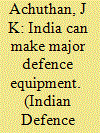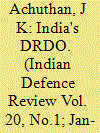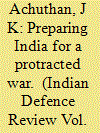| Srl | Item |
| 1 |
ID:
057808


|
|
|
|
|
| Publication |
Jul-Sep 2004.
|
|
|
|
|
|
|
|
|
|
|
|
|
|
|
|
| 2 |
ID:
015209


|
|
|
|
|
| Publication |
1993.
|
| Description |
66-68
|
|
|
|
|
|
|
|
|
|
|
|
|
|
|
|
| 3 |
ID:
089732


|
|
|
|
|
| Publication |
2009.
|
| Summary/Abstract |
The central Govt in India accords very high priority and funds allotment to cater for the equipment requirements of the Armed Forces. Yet the bulk of the major equipment requirements are either indigenously developed nor produced under the present evolved methodologies and practices.
|
|
|
|
|
|
|
|
|
|
|
|
|
|
|
|
| 4 |
ID:
051572


|
|
|
|
|
| Publication |
Jan-Mar 2004.
|
|
|
|
|
|
|
|
|
|
|
|
|
|
|
|
| 5 |
ID:
146564


|
|
|
|
|
| Contents |
In hostile interactions between nations, there are no rules for the victors till the status quo has been established. India is a continental country and should, therefore, have a realistic outlook
and possess strong land forces, unlike other nations which maintain strong navies and have
sea barriers to protect them. Wars, if fought, should have decisive outcomes so as to ensure a
century of peace thereafter, goes the old Clausewitzian dictum, The importance of restructuring
Indian army's battle groupings to fight decisive deep operations in order to permanently achieve the strategic upper hand should, therefore, not be lost sight of. Our national war aim should not be the capture of territories or assimilation of hostile populations but to ensure the destruction of enemhy forces, and a favourable outcome to neighbourly relations in the decades ahead. In the wars fought by India since independence, this reality has been significantly lacking in decision making inputs.
|
|
|
|
|
|
|
|
|
|
|
|
|
|
|
|
| 6 |
ID:
061446


|
|
|
|
|
| Publication |
Jan-Mar 2005.
|
|
|
|
|
|
|
|
|
|
|
|
|
|
|
|
| 7 |
ID:
119312


|
|
|
| 8 |
ID:
119379


|
|
|
| 9 |
ID:
056556


|
|
|
| 10 |
ID:
096318


|
|
|